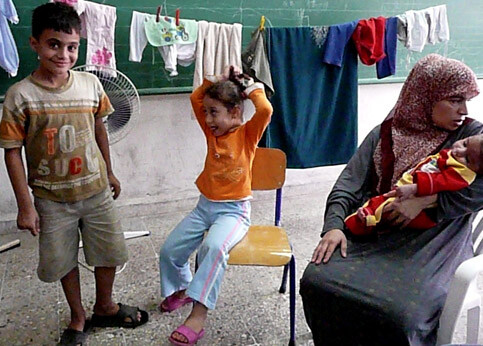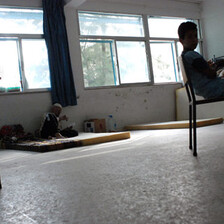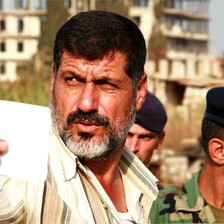Electronic Lebanon 29 October 2007

Souad al-Sayyed still lives in a classroom with her four-month-old baby, born after she left her home in Nahr al-Bared five months ago. (Lucy Fielder/IRIN)
BADDAWI, 28 October (IRIN) - Souad al-Sayyed still camps with her children in a classroom strung with washing lines, two months after the battle for Nahr al-Bared Palestinian refugee camp in northern Lebanon ended.
Despite the stench from the neighboring toilet and piles of rubbish in the corridors, Souad finds little comfort in the news that her time is up in her temporary home at a public school in Baddawi refugee camp, near the devastated camp.
“The school administration said they’re moving us out tomorrow, but nobody told us where we’re going,” she said, cradling her four-month-old son Hassan who was born during the army’s three-month siege of Nahr al-Bared, ending on 2 September.
Hassan’s temperature is always high and he has sleeping and breathing difficulties, she said, blaming the baby’s squalid surroundings.
On the morning of 25 October, up to 150 Lebanese residents protested against the school’s continued closure to pupils, according to its temporary Palestinian inhabitants and other witnesses. “They were insulting us and threatening to attack us. Fortunately, the army came along and moved them on,” said a father of four who gave his name as Abu Mohammed. “I can’t protect my children in this place.”
Anger at UNRWA
Two weeks after Palestinians started to trickle back to the “new camp” area of Nahr al-Bared, frustration is growing at what is seen as a slow pace of reconstruction and inadequate help. Anger is often directed at UNRWA, the UN agency for Palestinian refugees.
“UNRWA is responsible for Palestinian refugees and should at least have ensured their basic needs when they returned. There’s no electricity and only a little water, not enough for sanitation,” said Baddawi camp resident Khaled Yamani, who is a humanitarian coordinator for the Nahr al-Bared Relief Campaign and other NGOs. Most people who fled Nahr al-Bared left with only the clothes on their backs.
The challenge is vast. UNRWA estimates the battle between the army and Islamic militant group Fatah al-Islam destroyed or rendered uninhabitable as much as 85 percent of homes in the camp and ruined infrastructure. The camp’s up to 40,000 residents were forced to flee, many of them sheltering in the already overcrowded Baddawi camp, 10km south.
At least 169 soldiers, 287 insurgents and 47 civilians were killed in the army’s battle with the al-Qaeda-inspired militants, which broke out on 20 May with a police raid on a suspected hide-out linked to the group. In response, Fatah al-Islam fighters overran an army checkpoint outside their base in Nahr al-Bared, killing 33 soldiers.
The camp remains off-limits to journalists and rights groups, but the view from the road outside is of ruins of buildings folding into each other like crumpled paper. Few appear to be standing.
“Conditions are difficult but we’re doing our best to provide the basics. It’s very dusty, there’s still no electricity, very little water and only a few generators are working, though not all the time,” Hoda al-Samra, UNRWA spokeswoman, said.
She said the occupants of the two remaining inhabited schools would be moved to temporary homes or a rented building in the new camp.
Temporary homes
UNRWA has erected 30 temporary homes in the new camp and expects to finish 116 more in about three weeks. Each home can house one family. The agency is negotiating the lease of another plot to build more, to eventually house as many as 1,000 families.
Local residents have protested against the plans and blamed the Palestinians for the presence of Fatah al-Islam, which is a pan-Islamic rather than Palestinian militant group, in the camp.
Aid worker Yamani said UNRWA made such promises months ago, and frustration among the displaced is growing. And even the temporary homes people have been moved into remain rough and unfinished, he said.
Hassan Faour, a volunteer from Baddawi camp working with Save the Children, has been helping assess children’s needs inside Nahr al-Bared. He described the temporary houses as a “disaster.”
“They look okay from the outside, but there’s nothing in them, just bare brick walls and concrete floors. People call them the cowsheds — they’re fit for animals, not humans,” he said.
Other humanitarian workers who have seen the new homes, which are inside the camp and not visible from the road, described them as cramped and housing families of eight or 10 members. They have no windows yet, causing privacy concerns and discomfort when it rained this week.
“We acknowledge that they’re small and we put them up very quickly to get people out of the difficult conditions they were living in,” UNRWA’s al-Samra said, adding that there were plans to build larger houses for bigger families.
Local Palestinian coordinators in Baddawi estimate that more than 900 families, or 5,000 people, have returned to Nahr al-Bared, a small fraction of those displaced by the camp’s destruction.
Lack of coordination
Michael Copland, Programme Adviser for the Norwegian Refugee Council (NRC), stressed the need for enhanced coordination between agencies. “There’s a high level of frustration within host communities who are dealing with severe overcrowding,” he said. “There’s a need for regular and clear updates and as much involvement of them [local community] in the process as possible.”
Humanitarian groups are working in an unusually complex environment, Copland said, because of the sometimes conflicting needs of the displaced and the local Lebanese.
“Coordination should take many forms including providing information to the Lebanese and the military in terms of securing access and working with civilians, to make the best use of resources,” he added.
Non-governmental organizations the NRC, Premiere Urgence and ACTED (Agency for Technical Cooperation and Development) plan to distribute tool kits so that returnees to the new camp can begin repairing their homes.
The International Committee of the Red Cross (ICRC) has launched a three-month plan to repair damaged water networks, sewage pipes and four wells. It will also install a generator to pump water from another well and extend a water pipeline to the plot of UNRWA’s temporary homes.
This item comes to you via IRIN, a UN humanitarian news and information service, but may not necessarily reflect the views of the United Nations or its agencies. All IRIN material may be reposted or reprinted free-of-charge; refer to the copyright page for conditions of use. IRIN is a project of the UN Office for the Coordination of Humanitarian Affairs.
Related Links


